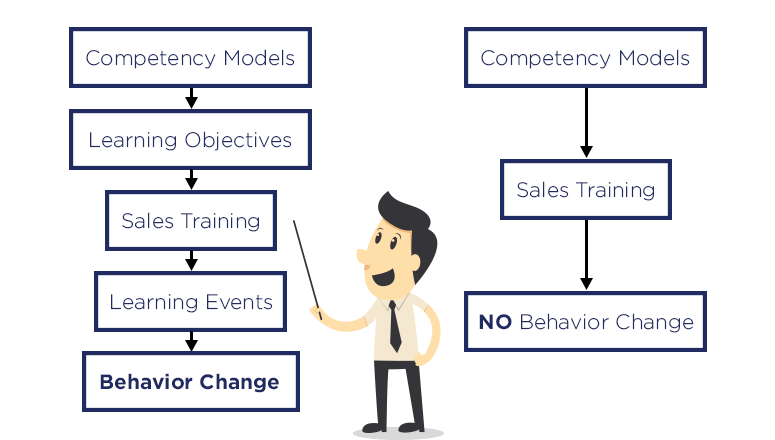Early this year, I attended a conference for medical device sales training professionals. I expected to hear about innovative ways organizations are training their reps, reinforcing value statements and sustaining training after product launch events.
I was wrong!
Instead, I heard many sessions about competencies and competency modeling. Having the right competency model in place is critical for sales reps and account managers. Once the right sales competencies are in place, we can coach reps to meet these competencies, measure their performance against the competencies, spot high performers and identify weak ones. Competency models are hard to get right, so it’s no surprise that so many sales training functions spend a whole lot of time making and revising them.
Competency models are a terrific tool for hiring and firing. They are valuable to managers and they help stakeholders decide what training should be created. But they are not helpful at ensuring that training is effective. Let me explain.
Know, Do, Believe, Avoid

Let’s use the common sales competency new account acquisition as an example. Assume you are a sales training manager who must design and implement a program to help sales reps develop their ability to acquire new accounts. Where would you begin?
If your competency model is solid, you will have a precise picture of how new account acquisition should be done. You’ll even be able to observe reps (and look at sales data) to see who is strong in the competency and who isn’t. But this does not help low or average performers get from Point A to Point B.
This is where learning objectives come into play. For the uninitiated, learning objectives are statements that tell us what learners will know, do, believe or avoid after completing training. Rather than saying “This training will teach new account acquisition,” learning objectives force us to get specific:
- Follow the 6 steps in the XYZ selling process.
- Position ACME corp. products with new accounts.
- Segment accounts by size, type and product lines used.
- Demonstrate superior listening skills with new prospects.
Essentially, learning objectives drive the granular behaviors that someone must perform to master a competency. By deciding what learning objectives are needed to meet a competency, you can ensure that training covers the appropriate content.
But even if your learning objectives are solid and they support your competency, you’re still a ways away from true performance improvement.
Optimize the Learning Experience

This is why instructional designers (IDs for short) stay employed. They know how adults learn best and they tailor the learning experience so each learning objective is met. We call our IDs learning designers.
A good learning designer will:
- Winnow your subject matter down to what is truly essential to meet the learning objectives.
- Employ a variety of interactions, activities and modalities to present the training content in a way that is memorable.
- Craft meaningful scenarios that provide safe practice opportunities for learners.
- Break content into small manageable chunks (like microlearning).
- Incorporate appropriate performance support and reinforcement tools into a training experience to extend the learning.
And with the broad range of learning technologies available today, a learning solutions company can take sound instructional design further by incorporating mobile apps, game-based experiences, custom videos and more.
Most importantly, learning designers make sure training is designed based on the science of how people learn and remember. They identify what behaviors sales reps will need to exhibit in order to reach your competencies and design learning experiences that make it stick.
So if you’ve just recently finalized your competency model for sales reps, that’s great! You have the foundation, but you’ll need effective training to take them from theory to reality.
Want to take your sales training further? Our Sales Enablement and Beyond webinar will show you how:




